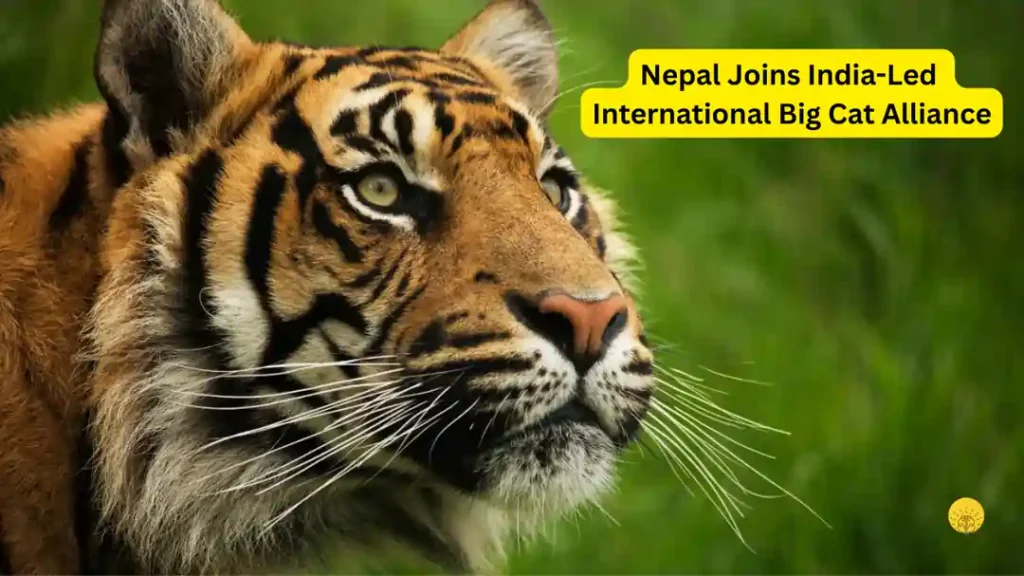New Delhi: In a landmark move for wildlife conservation, Nepal has officially become a member of the International Big Cat Alliance (IBCA), an India-led global initiative dedicated to protecting seven iconic big cat species. The announcement, made on Saturday, August 24, 2025, marks a significant step in strengthening international collaboration to safeguard tigers, lions, leopards, snow leopards, cheetahs, jaguars, and pumas. Nepal’s entry into the IBCA, formalized by signing the Framework Agreement, brings the total number of member countries to 13, with India at the helm of this ambitious coalition.

A Global Mission Rooted in India’s Conservation Legacy
The International Big Cat Alliance was launched on April 9, 2023, in Mysuru, Karnataka, by Indian Prime Minister Narendra Modi, coinciding with the 50th anniversary of India’s transformative Project Tiger. The IBCA, headquartered in India, is a multi-country, multi-agency coalition uniting 95 big cat range countries and non-range nations with a shared interest in conservation. Its primary aim is to foster global cooperation to protect seven big cat species: tigers, lions, leopards, snow leopards, cheetahs, jaguars, and pumas.
India’s leadership in this initiative draws on its exemplary track record in big cat conservation, particularly through Project Tiger, which has significantly bolstered tiger populations, and successful models for conserving lions, leopards, and snow leopards. The IBCA serves as a platform for member countries to share expertise, mobilize resources, and develop innovative solutions to address threats like habitat loss, poaching, and human-wildlife conflict.
“Nepal has formally joined the International Big Cat Alliance (IBCA) by signing the Framework Agreement,” the IBCA announced, emphasizing the ecological significance of this partnership. “With snow leopards, tigers, and common leopards in its landscape, Nepal’s joining will strengthen global collaboration for big cat conservation,” the statement added, congratulating the Government of Nepal for this pivotal step toward shared ecological security.
Nepal’s Conservation Triumphs and Strategic Role
Nepal’s inclusion in the IBCA is particularly significant given its remarkable achievements in wildlife conservation. The Himalayan nation has nearly tripled its tiger population, from just 121 in 2009 to 355 in 2022, according to the latest census. This success, driven by robust anti-poaching measures, habitat restoration, and community engagement, positions Nepal as a key contributor to the IBCA’s mission.
Home to three of the seven big cat species targeted by the IBCA—tigers, snow leopards, and common leopards—Nepal’s diverse ecosystems, ranging from lowland Terai grasslands to high-altitude Himalayan slopes, offer critical habitats. The snow leopard, often elusive in Nepal’s rugged mountains, the tiger in its lush forests, and the adaptable common leopard across varied terrains highlight the country’s biodiversity. By joining the IBCA, Nepal gains access to international expertise, funding, and technologies, which could further enhance its conservation strategies, particularly for the vulnerable snow leopard.
The IBCA highlighted Nepal’s role, stating, “Nepal’s participation will strengthen global collaboration for big cat conservation.” This partnership is expected to facilitate knowledge exchange, such as India’s advanced monitoring techniques and Nepal’s community-based conservation models, creating a synergy that benefits all member nations.
The IBCA: Structure and Vision for Global Impact
The IBCA’s structure is designed to maximize inclusivity and impact. Comprising 95 countries—both big cat range nations and those with conservation interests—the alliance fosters a collaborative environment. Currently, 13 countries, including India and now Nepal, are active members, with the secretariat in India coordinating efforts. This multi-agency approach involves governments, environmental organizations, and wildlife experts, ensuring comprehensive strategies to tackle pressing conservation challenges.
The alliance’s vision is to create a united front against threats to big cats, including habitat fragmentation, illegal wildlife trade, and climate change. By providing a platform for countries to share best practices and resources, the IBCA aims to replicate successes like India’s Project Tiger and Nepal’s tiger population recovery on a global scale. For those searching for “International Big Cat Alliance members” or “big cat conservation initiatives,” Nepal’s membership underscores the alliance’s growing influence.
A Milestone Announcement and Global Reactions
The IBCA’s announcement on August 24, 2025, was widely disseminated through official channels and social media platforms, including WhatsApp, Facebook, Twitter, and direct link sharing. News outlets, such as PTI and The Hindu, published detailed reports, accompanied by representative images of big cats, emphasizing the significance of Nepal’s entry. The announcement, made in Kathmandu, resonated with conservationists and policymakers alike, who see it as a step toward global ecological security.
The IBCA’s congratulatory message to Nepal highlighted the shared benefits of this partnership. “This is a significant step towards shared ecological security,” the statement read, underscoring the alliance’s commitment to fostering international cooperation. For those researching “Nepal IBCA membership” or “global big cat conservation 2025,” this development signals a promising advancement in collaborative efforts.
Nepal’s Conservation Journey: A Model for Success
Nepal’s tripling of its tiger population over 13 years is a testament to its dedication to conservation. From 121 tigers in 2009 to 355 in 2022, this achievement reflects rigorous census efforts, strengthened anti-poaching patrols, and community-driven initiatives. These efforts align seamlessly with the IBCA’s goals, making Nepal a valuable addition to the alliance.
The presence of snow leopards, tigers, and common leopards in Nepal’s landscapes adds to its strategic importance. Snow leopards, facing threats from climate change and habitat encroachment in the Himalayas, require specialized conservation approaches. The IBCA’s resources could support advanced tracking and habitat protection programs, while Nepal’s expertise in community engagement could inspire other member nations.
India’s Leadership and the IBCA’s Global Reach
India’s role as the IBCA’s founder and host nation is rooted in its long-standing conservation legacy. The launch of the IBCA in Mysuru in 2023 was a celebration of Project Tiger’s 50 years of success, which has seen India’s tiger population rebound significantly. India’s expertise in conserving lions in Gir Forest, snow leopards in the Himalayas, and leopards across diverse habitats provides a blueprint for other nations.
The IBCA platform enables big cat range countries to exchange knowledge and resources, addressing common challenges like poaching and habitat loss. For instance, India’s use of technology in wildlife monitoring could benefit Nepal’s snow leopard programs, while Nepal’s community-based models could inform conservation strategies elsewhere.
Challenges and Future Prospects
Despite the optimism surrounding Nepal’s membership, big cats continue to face significant threats globally. Habitat loss due to deforestation, human-wildlife conflicts, and climate change pose ongoing challenges. The IBCA’s collaborative framework aims to address these through shared resources and innovative solutions, such as transboundary conservation initiatives for species like the snow leopard, which Nepal shares with neighboring countries.
Looking ahead, the IBCA seeks to expand its membership and initiatives. Nepal’s entry could encourage other nations to join, amplifying the alliance’s impact. For those searching “big cat conservation challenges” or “IBCA future plans,” Nepal’s involvement highlights the potential for collective action to drive meaningful change.
Conclusion: A Unified Effort for Big Cat Survival
Nepal’s official entry into the International Big Cat Alliance on August 24, 2025, marks a pivotal moment in global conservation. By signing the Framework Agreement, Nepal joins 12 other nations, led by India, in a coalition of 95 countries dedicated to protecting tigers, lions, leopards, snow leopards, cheetahs, jaguars, and pumas. With its impressive tiger population growth and diverse big cat species, Nepal strengthens the IBCA’s mission to ensure ecological security.
Launched by Prime Minister Narendra Modi in 2023, the IBCA, headquartered in India, is a beacon of hope for big cat conservation. Nepal’s membership, celebrated in Kathmandu and globally, underscores the power of international collaboration. As the alliance grows, it continues to inspire searches for “Nepal big cat conservation” and “International Big Cat Alliance updates,” signaling a brighter future for these majestic species.
Frequently Asked Questions (FAQs)
1. What is the International Big Cat Alliance (IBCA), and why did Nepal join it?
The International Big Cat Alliance (IBCA) is an India-led global initiative launched on April 9, 2023, in Mysuru, Karnataka, to foster conservation of seven big cat species: tiger, lion, leopard, snow leopard, cheetah, jaguar, and puma. Headquartered in India, the IBCA is a coalition of 95 big cat range and non-range countries aimed at sharing expertise and resources. Nepal joined the IBCA on August 24, 2025, by signing the Framework Agreement to strengthen global collaboration, leveraging its success in tripling its tiger population from 121 in 2009 to 355 in 2022 and its habitats for snow leopards, tigers, and common leopards.
2. How does Nepal’s membership benefit big cat conservation?
Nepal’s inclusion in the IBCA enhances global efforts by bringing its expertise in tiger conservation and community-based models. With snow leopards, tigers, and common leopards in its diverse landscapes, Nepal contributes valuable insights to the alliance’s 13 member countries. Membership provides access to international resources, advanced technologies, and funding, potentially boosting efforts to protect vulnerable species like the snow leopard and fostering transboundary conservation initiatives.
3. What is the significance of Nepal’s tiger population growth?
Nepal nearly tripled its tiger population from 121 in 2009 to 355 in 2022, as per the latest census, showcasing its effective conservation strategies, including anti-poaching measures and habitat restoration. This success aligns with the IBCA’s goals and positions Nepal as a model for other nations, strengthening the alliance’s efforts to replicate such achievements globally for all seven big cat species.
4. Who are the members of the IBCA, and what is its structure?
The IBCA comprises 13 member countries, including India and now Nepal, within a broader coalition of 95 big cat range and non-range countries interested in conservation. Headquartered in India, the alliance operates as a multi-agency platform involving governments, environmental organizations, and wildlife experts. It facilitates knowledge exchange, resource mobilization, and collaborative solutions to address threats like habitat loss and poaching.
5. What challenges does the IBCA aim to address, and how does Nepal’s role help?
The IBCA tackles challenges such as habitat fragmentation, human-wildlife conflict, and climate change impacting big cats. Nepal’s role is pivotal due to its proven conservation strategies and diverse ecosystems hosting three big cat species. By sharing its community-driven approaches and benefiting from the IBCA’s resources, Nepal helps advance global strategies, potentially inspiring other nations and supporting initiatives like transboundary snow leopard conservation.

